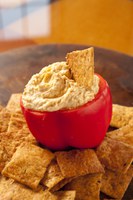Prairie Fare: Make Snack Attacks Count
(Click an image below to view a high-resolution image that can be downloaded)
By Julie Garden-Robinson, Food and Nutrition Specialist
NDSU Extension Service
“Make sure your seat belts are buckled and all carry-ons are properly stowed,” the flight attendant said.
I pushed my purse under the seat with my foot, cinched my seat belt and settled in by the window. Then I realized that my reading materials also were properly stowed in the overhead bin, which was closed.
I had nothing to read but the information about the aircraft, the safety pamphlet (including information about a water landing, which kind of scared me) and a well-used airline magazine. Even the crossword puzzle was done. I sat back and closed my eyes, but unfortunately, I can’t sleep on planes.
By the time we reached cruising altitude, the strangers in the seats next to me already were snoozing. Here I was six miles above the ground strapped in a pressurized tube with nothing to do except stare out the window at the fluffy clouds below me.
I was a little hungry because the two-hour flight passed over the lunch hour. I checked the flight magazine and saw that I could choose between a snack box full of candy or one with crackers, hummus and nuts. I chose the latter and I handed the flight attendant my credit card.
Opening all the tiny packages and balancing them on the small tray occupied me for a little while. I was seriously bored, so I began reading all the labels. Among other designations, the crackers were labeled “trans fat free,” “gluten free,” “GMO free,” “healthy” and “high fiber.”
Do you know what these food label designations mean? Check your knowledge with these very brief clues.
- What term refers to a food that does not contain proteins found in wheat, rye, barley and triticale?
- What term refers to a food that contains at least 5 grams of indigestible carbohydrate per serving?
- What term lacks a precise meaning when on the packages of food products?
- What term means the food has less than 0.5 gram of this food component, which is associated with raising “bad” cholesterol levels?
- What term indicates that the ingredient materials had not been genetically altered?
The answers are: 1. gluten-free; 2. high fiber; 3. natural; 4. trans fat free and 5. GMO free. Visit https://www.fda.gov to learn more about the complexity of food labeling.
If you are in need of a snack, keep it simple, be a snack label reader, and make your snack choices count with these tips and ideas from https://www.choosemyplate.gov:
- Save time by slicing veggies. Store sliced vegetables in the refrigerator and serve with dips such as hummus or low-calorie dressing. Top half of a whole-wheat English muffin with spaghetti sauce, chopped vegetables and low-fat shredded mozzarella, and melt in the microwave.
- Mix dried fruit, unsalted nuts and popcorn in a snack-size bag for a quick trail mix. Blend plain fat-free or low-fat yogurt with 100 percent fruit juice and frozen peaches for a tasty smoothie.
- Grab a glass of milk. A cup of low-fat or fat-free milk or milk alternative (soy milk) is an easy way to drink a healthful snack.
- Go for great whole grains. Offer your family whole-wheat breads, popcorn and whole-oat cereals that are high in fiber and low in added sugars, saturated fat and sodium.
- Nibble on lean protein. Wrap sliced, low-sodium deli turkey around an apple wedge. Store hard-cooked (boiled) eggs in the refrigerator to enjoy.
- Keep an eye on the size. Store snack-size bags in the cupboard and use them to manage serving sizes.
- Enjoy fresh, frozen, dried or canned fruits as easy “grab-and-go” options that need little preparation.
- Consider convenience. A single-serving container of low-fat or fat-free yogurt or individually wrapped string cheese can be just enough for a snack.
- Prepare homemade goodies. For homemade sweets, add dried fruits such as apricots or raisins and reduce the amount of sugar in the recipe. Adjust recipes that include fats such as butter or shortening by using unsweetened applesauce or prune puree for half the amount of fat.
I enjoyed the small amount of hummus in my airline snack box, but I can make a bowl of it for the same price at home. Try this easy recipe. Visit https://www.ag.ndsu.edu/familytable for more recipes and snack ideas.
Savory Hummus
1 (15-ounce) can chickpeas, drained and rinsed
4 Tbsp. tahini (sesame seed paste)
1/4 c. lemon juice
3 cloves crushed garlic
1/2 to 1 tsp. salt (to taste)
Puree chickpeas in blender or food processor. Add remaining ingredients and blend until smooth. The final product should be thick and smooth. Serve with carrot sticks and other vegetables, pita chips or whole-grain crackers. Or use as a spread on sandwiches.
Makes 12 servings. With 1/2 tsp. salt, each serving has 70 calories, 3 grams (g) fat, 3 g protein, 8 g carbohydrate, 2 g fiber and 150 milligrams sodium.
(Julie Garden-Robinson, Ph.D., R.D., L.R.D., is a North Dakota State University Extension Service food and nutrition specialist and professor in the Department of Health, Nutrition and Exercise Sciences.)
NDSU Agriculture Communication - Aug. 24, 2017
| Source: | Julie Garden-Robinson, 701-231-7187, julie.garden-robinson@ndsu.edu |
|---|---|
| Editor: | Ellen Crawford, 701-231-5391, ellen.crawford@ndsu.edu |



